Food safety

Many congregations offer or are considering offering food and drink for sale as part of community or social enterprises, or voluntarily as part of a wider community engagement. The law concerning food safety is complex, and, unfortunately, activities which involve the preparation and sale of food (including giving away food for free) within the Church of Scotland are not exempt.
The Church of Scotland Law Department has produced a useful health and safety circular which provides an overview of the legislative requirements for food safety. The Charity Trustees are strongly advised to familiarise themselves with the content of this circular.
Food safety legislation remains relatively static. The only significant change to food safety legislation in Scotland since this circular was produced is the changes to food labelling introduced on 1 October 2021. The requirements for the labelling of food that is pre-wrapped on site (known as ‘prepacked for direct sale') has changed. The new labelling aims to inform and protect consumers by providing ingredient and allergen information on the packaging (see food labelling section below).
The main responsibilities in terms of the law are to ensure that you do not include anything in food, remove anything from food, or treat food in any way that means it would be damaging to the health of people eating it; to ensure that the food you serve or sell is of the nature, substance, or quality which consumers would expect; and to ensure that the food is labelled, advertised, and presented in a way that is not false or misleading.
The information in this section of the toolkit focuses on good hygiene practices which should be followed when storing, handling, preparing, and serving food. This advice is equally applicable to churches that are already serving and preparing food and those that are considering doing so.
Aim of food safety management
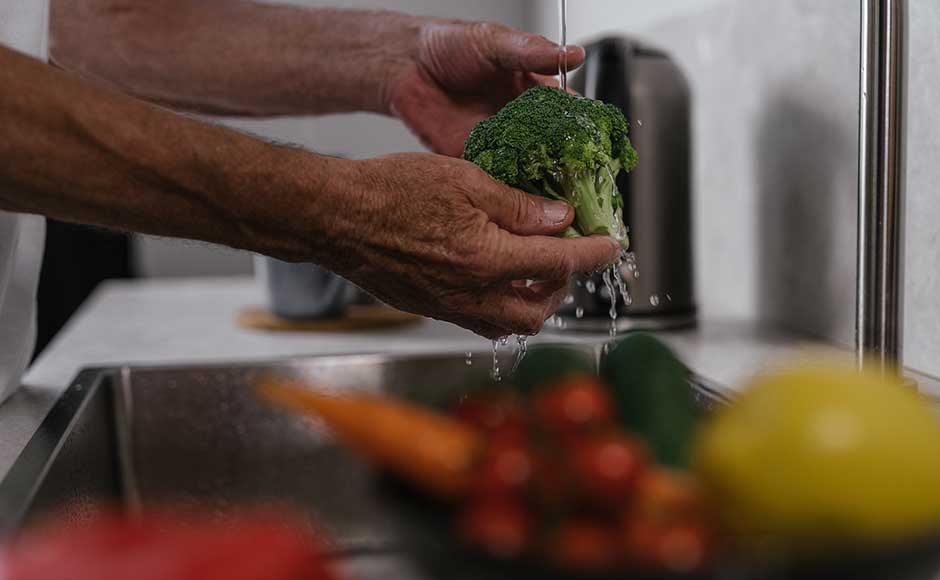
Food safety management incorporates the systems (rules and procedures) and processes (instructions) in place to prevent people from becoming ill from eating or drinking food that has been prepared and handled.
Food poisoning is still very common in Scotland and can affect anyone who eats or drinks (consumes) contaminated food. In most cases, infection will be mild and people will make a full recovery within a few days. However, there are some very serious foodborne infections which can have serious consequences, from lifelong disabilities to death. Those most at risk include the very young, the elderly, people who are already ill or recovering, and pregnant women and their unborn babies.
Food safety is not just about the cleanliness of kitchens. It is about ensuring that safe and sufficient practices are in place to ensure that anyone consuming food is protected from avoidable food hazards. Such practices include:
- Buying food from reputable suppliers
- Protecting food from the risks of contamination
- Preventing multiplication of bacteria which might be present in food
- Destroying harmful bacteria by ensuring that food is cooked properly
- Throwing away any unfit or contaminated food.
The Charity Trustees must develop and implement suitable and sufficient food safety systems and processes to reduce the likelihood of anyone becoming ill from food prepared and handled.
Allergenic hazards

Allergens are substances that can cause the body's immune system to respond with noticeable symptoms such as swelling of the throat and mouth, rashes, weakness and abdominal pain. In severe cases, anaphylactic shock can occur and may be fatal.
It is necessary to ensure that any foods prepared and offered are considered for allergens. This may involve labelling foodstuffs or communicating with your customers about which allergens might be present. It is acceptable to declare that you cannot confirm that any foodstuffs sold or provided are free from allergens. However, it is best practice to be as accommodating as possible.
The main food allergens to be aware of include celery, gluten, crustaceans, eggs, fish, lupin, milk, molluscs, mustard, nuts, peanuts, sesame seeds, soya, and sulphur dioxide.
All food handlers must be aware of the procedures to follow should anyone suffer an anaphylactic shock:
- Do not move the individual
- Call an ambulance immediately
- Ask if they have a preloaded adrenaline injection kit
- Try to keep the individual calm until assistance arrives.
It is important to communicate clearly with customers. If they advise that they have a food allergen, it is necessary to be honest and confirm if any are present. If you do not know, tell your customers this – do not guess. If possible, label any menus with details of any allergens present. When preparing food, use separate areas and equipment when handling ingredients which may cause an allergic response. Effective hand washing and thorough cleaning practices are also important.
Checklist for churches planning to introduce catering facilities
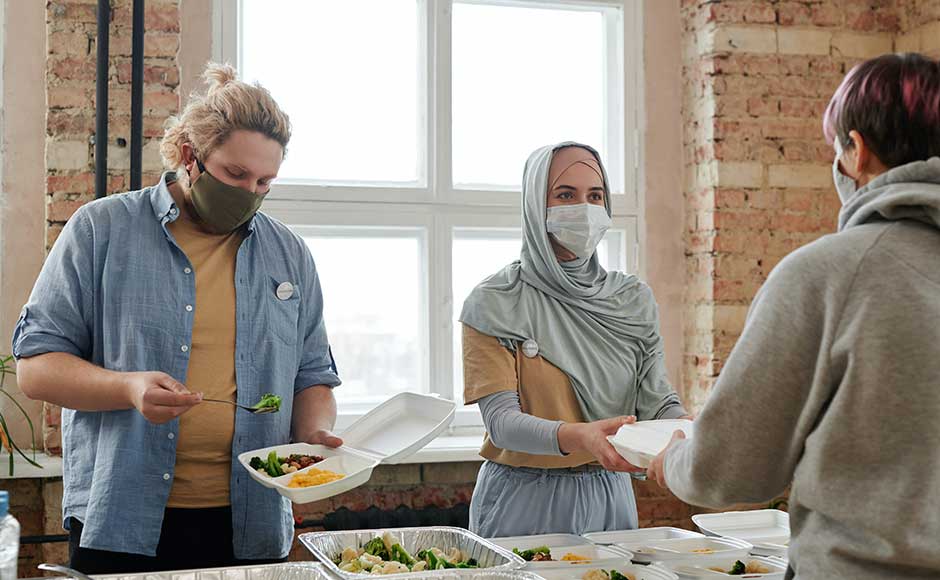
Food Hygiene Co-ordinator
If you are planning to introduce catering facilities you should appoint a Food Hygiene Co-ordinator, who should be available from the start until completion of the project, although thereafter there will be a monitoring exercise. This person may be the Property Convener, Halls Convener, or other existing Office Bearer.
Local Authority inspection
We recommend telephoning and arranging for the Environmental and Consumer Services of the Local Authority for your area to inspect church premises and provide guidelines on kitchen facilities. Also, ask their representative for the current leaflet on ‘Agencies Offering Food Hygiene Training’ and, separately, a Food Premises Registration Form for completion, if appropriate.
Follow their instructions on any alterations required, which will probably be relevant to work surfaces, storage space, sinks, hand wash basin and cleaning schedules. (This is not a complete list but these are likely areas of concern.) This may have financial implications.
Arrange training
Food handlers will need to be trained and competent. Arrange a certificate course (Elementary Food Hygiene) by a Royal Environmental Health Institute of Scotland Licensed Trainer. More advice is available in teh Food Hygiene Training section above. Seek advice and guidance from the General Trustees in the first instance about REHIS courses being offered.
Ensure that standards are maintained
Regularly review all arrangements and food handlers to ensure appropriate food safety standards are being maintained.
Chemical hazards
The most common chemical hazard in a kitchen is the inappropriate use of cleaning chemicals. Cleaning chemicals that are not used appropriately – for example, incorrect dilution or leaving chemicals on surfaces for too long – can present a significant risk of cross-contamination. No cleaning chemicals must be stored in the same room as food, including tins, cans, and packets of food. Cleaning chemicals must never be transferred to unmarked containers and chemicals must only be used as per the manufacturers' instructions.
Cleaning and disinfection
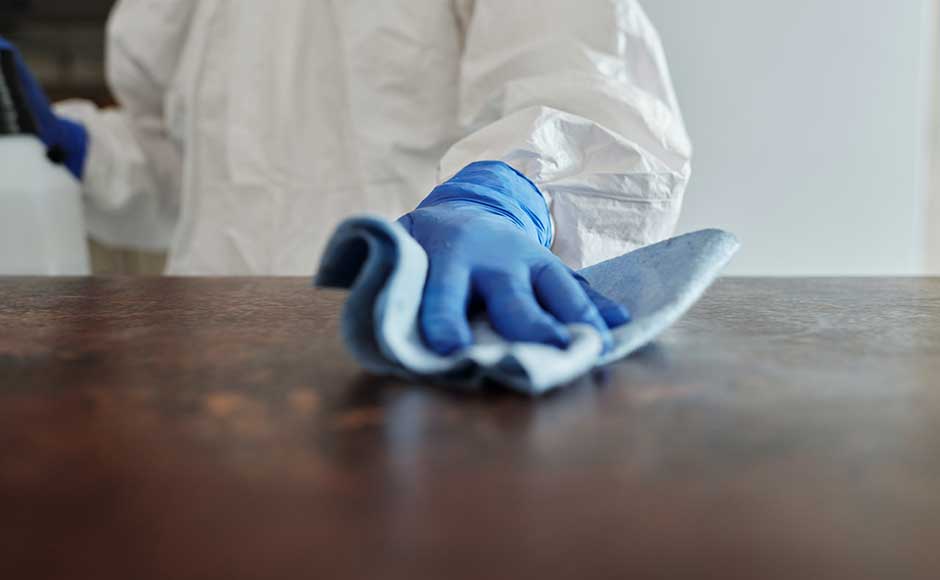
Cleaning is the process of removing food residues, dirt and grease. Detergents are usually used to clean.
Disinfection is the process of reducing microorganisms to a safe level and usually involves disinfectant. All disinfectants must meet BS EN 1276 or BS EN 13697. Please check the labels of any disinfectants to ensure that they comply with either of the standards before use. All food contact surfaces must be cleaned and disinfected regularly and at the end of the day.
Food handlers should be encouraged to clean up after themselves as they go along.
Cleaning schedules should be developed for all equipment and for the kitchen itself to ensure a planned and organised approach to cleaning.
Dishwashers are a useful addition to any kitchen. However, they must be serviced regularly (as per the manufacturer's requirements) and you need to be assured that the wash cycle reaches at least 60 degrees C and the rinse cycle reaches between 82 degrees C and 88 degrees C. Dishwashers should also be included in your cleaning schedule for regular cleaning.
Cross-contamination
It is important to consider cross-contamination in kitchens. Cross-contamination is the transfer of bacteria from one source (usually raw meat) to ready-to-eat foods. Cross-contamination can occur due to poor food handling practices, poor storage of foodstuffs (particularly in refrigerators) and poor cleaning.
It is important that all food handlers receive suitable training, instruction and supervision and that raw and cooked ready-to-eat foods are separated. Effective cleaning and disinfectant procedures should also be in place and separate hand washing sinks should be used instead of those used to wash food and equipment.
Food handlers and personal hygiene
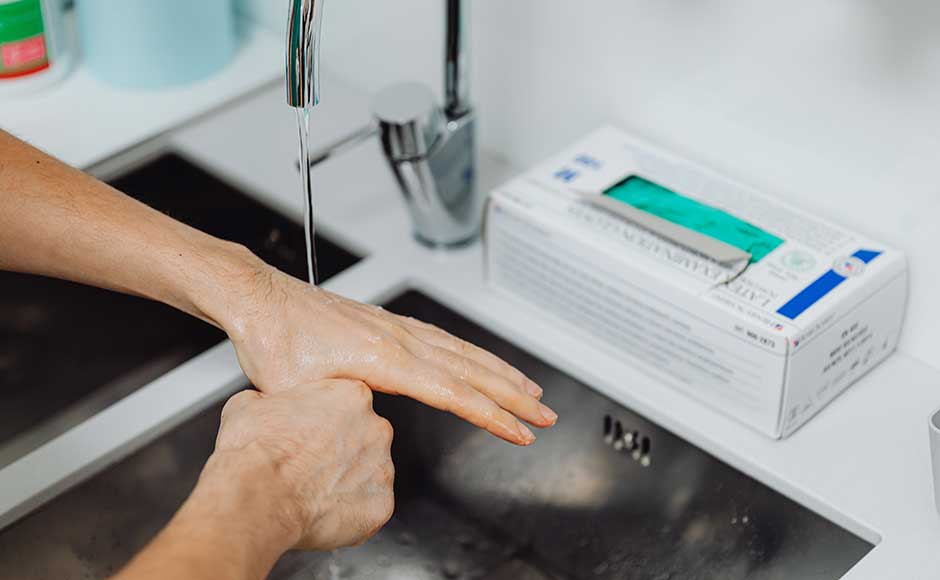
Charity Trustees must be confident that anyone handling food demonstrates awareness and understanding of good personal hygiene practices.
All staff must wash their hands thoroughly in warm water and have access to soap and a means of drying their hands. Hands should be washed after handling food waste or rubbish, cleaning or handling dirty equipment, visiting the toilet, handling raw foods, and on entering the kitchen.
Any cuts or sores must be appropriately cleaned and dressed with a waterproof dressing. Food handlers must not wear jewellery (a plain wedding band is acceptable) and hair should be tied back away from the face.
Clean protective clothing such as aprons must be worn by all food handlers. Disposable aprons are acceptable.
No food handlers must be allowed to work in or near any food areas if suffering from any gastroenteritis. Food handlers must wait at least forty-eight hours after the symptoms have stopped before working with food again. All staff must be aware of how to report any illness and to whom.
Food hygiene regulations
New food hygiene regulations came into force on 1 January 2006. These regulations are intended to cover all activities apart from the handling, preparation and storage of food for private domestic consumption. They will therefore apply to Congregational operations no matter how limited.
The hygiene principles underpinning the regulations are as follows:
- Compliance with microbiological criteria for foodstuffs
- Compliance with temperature control requirements
- Maintenance of the cold chain
- Appropriate sampling of foodstuffs to ensure compliance (e.g. use of temperature probe)
- Keeping premises (kitchens and all other accommodation used for the preparation or processing of food) clean and in good condition, with adequate facilities for cleaning food stuffs, washing utensils, etc
- Keeping temporary premises such as marquees or stalls clean, with adequate provision for hygienic preparation of food stuffs and washing utensils, etc.
The principal innovation in the regulations relates to the managing of food safety in line with what are known as Hazard and Critical Control Point (HACCP) principles. Essentially, these requirements relate to the minimising or managing of risk. HACCP is a food safety management system. Its main aim is to focus attention on critical points in an operation and to take measures to ensure that problems do not occur. The approach should be familiar to anyone with food safety training and should not involve anything unfamiliar to Congregational Food Safety Co-ordinators who have been on a training course.
Food hygiene training
The Food Safety Act 1990 requires that ‘food handlers’ (i.e. those who are involved in food preparation in any form more sophisticated than the making of tea/coffee and the provision of biscuits) "should be trained, instructed and supervised in food hygiene according to the work that they do". The regulations lay down no specific form of training, but obviously those who handle food will be expected to observe good personal hygiene, to wash their hands when handling food and never to smoke in food handling areas.
It is strongly recommended that Congregations arrange for structured training for volunteers and that they be encouraged to undertake the training offered to ensure that, as a minimum, there is at least one holder of an elementary Food Hygiene Certificate present when food in any form (beyond tea/coffee and biscuits) is being prepared on Church premises by members of the Congregation. It is also recommended that each Congregation appoints a Food Safety Co-ordinator with the appropriate level of training.
Where can I attend a Food Hygiene Course?
There are a number of ways to undertake the appropriate training. The course can be run by any provider approved by the Royal Environmental Health Institute of Scotland. The website provides a useful list of all the training centres in Scotland, which can be searched by area and details of the courses available at each venue.

Some Presbyteries have organised food safety training. It is worth checking with the Presbytery Clerk whether anything is planned in your area.
The Environmental Health Department of your local council will also be able to provide details of accredited courses.
Local Colleges, particularly those running courses on domestic science, can often provide food hygiene training.
Public and private training companies also provide food hygiene training, and your local council may have more information about what is available in your area.
How long does the Food Hygiene Certificate last?
There is no time limit for the life of a certificate and no requirement for refresher food hygiene training. However, most authorities recommend that all food handlers update their training every three years. This will be particularly important if there have been any changes in food safety legislation or food handling practice.
Food labelling
The law requires registered food businesses to be able to tell consumers if there are any of 14 specified allergens present in the food they are going to buy.
As the law only applies to businesses, in general the labelling regulations do not apply to most food being sold by congregations. This includes food sold at one-off events such as church fêtes or coffee mornings. However, it is good practice to consider the risks.
If your congregation runs events which are more regular and organised, e.g. a café, it is likely to be registered with the local authority as a food business. In that case, the labelling provisions apply. If you sell loose foods – food not in its original manufacturer's packaging – then your customers must be able to find out if any of your food contains any of the 14 allergens specified in the regulation.
The 14 allergens need to be mentioned either on a label or provided on a menu. If they are on a label with other ingredients, they must be highlighted in some way, so they stand out. You could also have a notice directing people to speak to kitchen staff for more information. Staff will then need to be made aware of what ingredients are in the food so that they can answer any queries about allergens.
The 14 allergens which need to be mentioned are:
- Eggs
- Milk
- Peanuts
- Molluscs
- Mustard
- Nuts
- Sesame seeds
- Soya
- Cereals containing gluten
- Lupin
- Fish
- Celery
- Crustaceans
- Sulphur dioxide

Providing tea and biscuits after church on a Sunday would not fall under the definition of a food business, but it would still be best practice to avoid serving items such as biscuits containing nuts or any of the other allergens. In this case, where biscuits are provided from a packet, you could retain the packet so that you can answer any queries about ingredients by referring to it.
Some local authorities have already made direct contact with Congregations who are registered in their area as a food business.
Please ensure that your church is fully aware of the legislation and rules for the food products and items that are being prepared and offered for consumption. Additional information and guidance is available on the Food Standards Scotland website.
Food premises and equipment
All kitchens, food storage areas and food preparation areas must be designed and constructed in such a way as to prevent any risk of cross-contamination. This does not mean that a full commercial kitchen with, for example, stainless steel worktops is required. However, it does mean that the following should be put in place:
- Separate equipment for raw and high-risk foods (e.g. knives, chopping boards)
- Separate areas for raw and cooked foods. If this is not possible, strict cleaning and disinfection must be undertaken and the handling of raw and ready-to-eat foods must occur separately and not at the same time.
- Suitable facilities for personal hygiene, for example, a designated hand wash basin
- Adequate facilities for refrigeration and freezing to accommodate the volume of food used
- Adequate pest control, for example, no open windows, all structural defects fixed
- Adequate lighting – no glass bulbs to be used in the kitchen without suitable coverings
- Kitchens and equipment able to be thoroughly cleaned and disinfected
- Satisfactory supply of drinking water in all food premises
- Walls, floors and ceilings must be hard- wearing, waterproof, non-flaking and easy to clean.
Food safety hazards

Four main groups of hazards are associated with food safety:
- Microbiological, such as bacteria, viruses and moulds
- Physical, such as glass, plastic, hair and skin
- Chemical, such as pesticides and cleaning materials
- Allergenic, such as peanuts, shellfish, eggs and milk
Food safety regulations require:
- Identification of where any food safety hazards might exist
- Implementation of effective controls to prevent them from causing harm.
Food safety management requirements
Under the existing law, those responsible for any sort of operation where food is prepared and served should carry out risk assessments and, as stated, premises should continue to be operated in a safe and hygienic way. But a more structured approach to managing the operation may be required and records may need to be kept.
The requirements will vary depending on the level of operation. Congregations that provide café facilities or the like will be most affected. Congregations that have monthly or fortnightly events such as lunch clubs will be less affected, but nonetheless appropriate procedures must be in place and records kept (as detailed below). The food hygiene regulations apply in all circumstances where food is brought onto premises but in the case of low-risk activities, simplified procedures and record keeping should suffice.
The basic food safety management requirements are as follows:
- Identifying risks to food safety which might be present or occur within your operation ("What can go wrong, when and where?").
- Putting controls in place which will deal with the risks ("What can I do about it?").
- Ensuring that controls are carried out and that if something does go wrong, it is clear to all involved what should be done to rectify the problem ("What is acceptable?", "How can I check?", "What can I do about it?").
- Ensuring that the procedures are kept up to date ("How do I confirm that the procedures are still working?").
- Keeping the documents and records necessary to show health inspectors that the procedure is working and is reviewed where necessary ("What documents and records do I need?").

Guidance should be available from the Environmental Health Department of the relative local authority and it is strongly recommended that such advice is obtained and acted upon. Details of the HACCP documentation for record keeping are provided in the Food Standards Agency Cooksafe publication, which should be available from local authorities. It can also be accessed at the Food Standards Scotland website.
The publication provides detailed advice which is tailored for commercial operations, and in most cases simplified versions of the example documentation should suffice. While references to record-keeping may appear daunting, once the basic documentation (such as flow charts and check lists) is in place, monitoring by the Congregation's Food Safety Co-ordinator should be fairly straightforward.
It is recommended that each Congregation has a Food Safety Co-ordinator with the appropriate level of training and that he or she is responsible for implementing the risk assessment, reviewing the procedures and keeping records.
Home preparation of food

The Law Department frequently receives enquiries as to whether or not Congregations may allow food which has been prepared at home to be brought to the Church for consumption or sale. There is no outright ban on this. However, assessments as to risk must be carried out.
While there would normally be no problem with cakes which do not have high-risk ingredients, such as fresh cream, there may be a degree of risk with all other foods and, as a general rule, it is safer to avoid bringing in high-risk foods which have been prepared at home. Such items should therefore be prepared within the church premises or be bought in from commercial sources.
Whether procedures must be applied and documentation kept in respect of low-risk items such as cakes will depend on the circumstances. If ‘home cooking’ is being donated in connection with an event, then it may be appropriate to record the source and, of course, items should then be handled and stored safely.
There may be labelling requirements (see section below) so far as items such as jams and cakes sold at church fetes and the like are concerned.
Liability and insurance
Although any civil claim for damages arising from a case of food poisoning would, it is anticipated, be covered by a congregation's public liability policy, such a policy does exclude deliberate acts or omissions. There is, therefore, possible that the insurance cover might be withdrawn by the company and personal liability would attach to individual office-bearers in cases where those office-bearers were aware that standards in the church kitchen where the food was handled or prepared were manifestly unsafe.
Congregations that have specific enquiries in regard to the above or with respect to food safety generally should contact the Law Department on 0131 225 5722 or email lawdept@churchofscotland.org.uk for further guidance.
Microbiological hazards
There will always be a risk of microbiological hazards being present in food at one time or another. Bacteria is the most common microbiological hazard and some can produce toxins and spores which can cause illness. Bacteria require a suitable temperature (warmth), food, moisture and time to grow. Bacteria can grow very quickly in the right conditions.
Temperature control
Temperature control is one of the most effective means of reducing the risk of microbiological hazards causing illness. The key temperatures to be aware of are as follows:
- Food should be kept below 5oC and above 63 degrees C at all times, except when being prepared for cooking or serving. This temperature range is known as the ‘danger zone’ and is the best temperature for bacteria to multiply.
- Refrigerators should operate between 1 degree C and 5 degrees C
- Freezers should operate between -18 degrees C and -24 degrees C
- Food should be cooked until the centre of the food reaches a minimum of 75 degrees C
- Food that is reheated must reach a temperature of 82 degrees C. Stews and liquid food should be reheated to boiling point.
- Food which is to be kept warm must be held at a temperature of at least 63 degrees C.
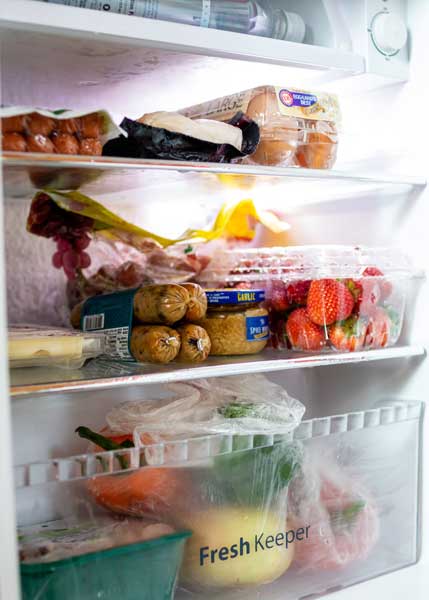
All kitchens should have a digital probe thermometer and disinfectant wipes for checking that the correct temperatures are reached. You must follow the manufacturer's instructions on how to calibrate and use the digital probe thermometer. All temperatures must also be recorded and the records kept in a safe place.
Temperature control is very important, particularly when handling and preparing high-risk foods such as cooked meats, meat products, dairy produce, eggs, shellfish and cooked rice. If cooking such products in advance, they must be cooled down quickly and refrigerated. If reheating, please follow the guidelines above on temperature control.
Raw meat for cooking is not a high-risk food because any bacteria present will be destroyed in the cooking process. More information about precautions that should be taken when handling and cooking raw meat is covered in the Food Handling and Personal Hygiene section below.
Outside caterers and church lets
Only outside caterers who hold the Elementary Food Hygiene Certificate should be used, and you should ensure they have adequate insurance cover.
Let agreements for outside agencies should include the requirement for Food Hygiene Certificate Holders.
Physical hazards
Physical hazards present a significant risk of choking, cuts and broken teeth. Sources of physical hazards in a kitchen include:
- Raw ingredients (stones, pests, bones, dirt)
- Building/equipment (screws, wood, paint flakes)
- Notice boards (pins, paper)
- Packing material
- Maintenance activities
- Food handlers (jewellery, fingernails, buttons, plasters, and fibres)
- Pests (droppings, webbing, feathers).
The best control methods for physical hazards include the satisfactory design, construction and maintenance of kitchens.
Damaged or unsuitable equipment must be replaced and staff must be trained how to use kitchen equipment properly. Soft woods should not be used in the construction of kitchens or equipment and staff and volunteers need to know what to do in cases of glass breakage. Kitchens should be inspected regularly for assurance that no evidence exists of any pest activity (mice, rats, birds, etc.). Staff must be trained in personal hygiene matters and, if appropriate, personal protective clothing such as aprons should be provided.
Re-use of jam jars for sale or giving away at Church events
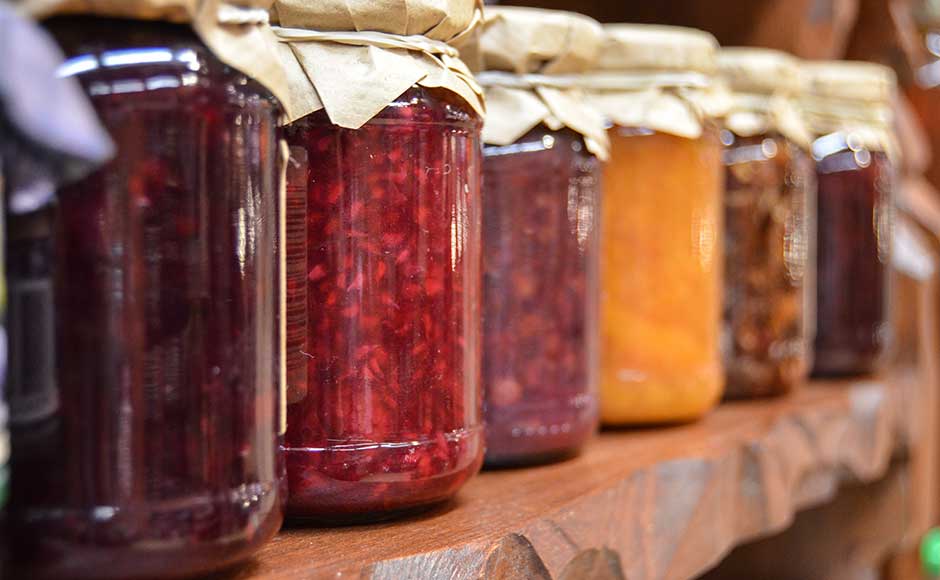
The Food Standards Agency in Scotland has advised that they are not aware of any evidence of food safety concerns for consumers from cross-contamination by the re-use of glass jars.
They stress the need for good hygiene in cleaning the jars at adequate temperature and the preparation of the jam or chutney to be put in them. It is for local authority Environmental Health Officers to decide how to enforce regulations with respect to charities and similar organisations, but as far as the FSA is aware there has never been a prosecution for re-using jam jars since the regulations were introduced in 2004. The regulations need to be applied with common sense and good hygiene should be observed at all times.
Requirement to register premises
In terms of the regulations made under the Food Safety Act 1990, premises used for a food business on five or more days in any period of five consecutive weeks (whether or not carried on for profit) must be registered. However, premises used for voluntary or charitable organisations where no food is stored for sale are exempt from registration as are:
- Premises where the only commercial operations comprise the sale of food from automatic vending machines
- The supply of beverages, biscuits etc. where the principal activity of the business is not the sale of food
- The supply of food in the course of a religious ceremony.
Many Church premises may, therefore, be exempt from the requirement to register. However, it is strongly recommended that, in all cases (and particularly if there is any doubt as to whether any activity could constitute the storage of food), you should contact officials of the Local Authority Environmental Health Department, who should be invited to inspect the premises.
Irrespective of any requirement to register, congregations should be diligent in following up promptly any recommendations made by Environmental Officers as to improvements to be made to the facilities and in regard to cleaning and general hygiene.
Waste storage and disposal
Suitable arrangements must be made for the storage and removal of all food waste and other materials from the kitchen. No waste material must be stored in the kitchen itself and all bins must have lids to prevent pests. Bins must be cleaned and disinfected thoroughly after use.